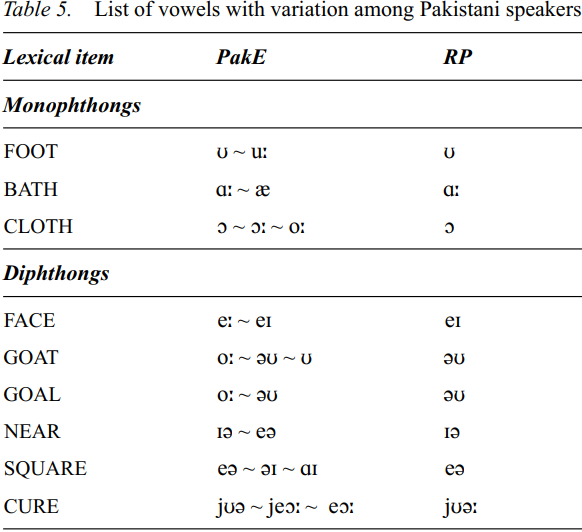


 Grammar
Grammar
 Tenses
Tenses
 Present
Present
 Past
Past
 Future
Future
 Parts Of Speech
Parts Of Speech
 Nouns
Nouns
 Verbs
Verbs
 Adverbs
Adverbs
 Adjectives
Adjectives
 Pronouns
Pronouns
 Pre Position
Pre Position
 Preposition by function
Preposition by function 
 Preposition by construction
Preposition by construction
 Conjunctions
Conjunctions
 Interjections
Interjections
 Grammar Rules
Grammar Rules
 Linguistics
Linguistics
 Semantics
Semantics
 Pragmatics
Pragmatics
 Reading Comprehension
Reading Comprehension|
Read More
Date: 2024-05-22
Date: 2024-06-09
Date: 2024-06-18
|
There was some variation in the vowels in this group as realized by Pakistani speakers. These vowels are again grouped within the chart as monophthongs and diphthongs and are listed in Table 5 below. While this paper documents variation in the realization of these vowels in PakE (of native speakers of Urdu), the range and distribution of these variations within the community has not been examined.

The vowel in FOOT varies between a lax mid-high rounded back vowel, [ʊ] , and a tense high rounded back vowel, [u:]. The vowel in BATH varies between a tense low back vowel, [ɑ:], and a lax low front vowel, [æ]. The vowel in CLOTH is realized as a tense mid back vowel, [ɔ:] , a tense mid-high back vowel, [o:], or a lax mid back vowel [ɔ]. In all the three cases here, it appears that the vowels vary between a tense and a lax form. In addition, another commonality between the pronunciations of these three words is that, while some speakers of PakE use the same vowel as in RP, others have a slightly raised variant.
The diphthongs in FACE, GOAT, and GOAL in PakE vary between a diphthong and a monophthong. Whereas Rahman (1990: 25–26 and 90) suggests that monophthongisation is a general characteristic (especially in case of [eɪ] → [e:]) of PakE, data here shows that there is variation across speakers. In all three cases, two speakers (the same ones) use a diphthong while the other four use a monophthong.
The diphthongs and triphthongs in SQUARE and CURE respectively vary between being centring and closing. The centring diphthong in NEAR varies in its point of origin. One of them starts from a mid-high vowel, [ɪ] , and the other from a mid-low vowel, [e].
|
|
|
|
التوتر والسرطان.. علماء يحذرون من "صلة خطيرة"
|
|
|
|
|
|
|
مرآة السيارة: مدى دقة عكسها للصورة الصحيحة
|
|
|
|
|
|
|
دراسة تستعرض آلام السجناء السياسيين في حقبة البعث المجرم في العراق
|
|
|